South African Tide Pooling Guide, Part 1
Posted by Enrico Gennari on June 17, 2023
Part 1 of our comprehensive guide to tidepooling in Mossel Bay
This guide was created by our 2018 field specialist Kiana Crook to identify intertidal invertebrate species in Mossel Bay. Our intertidal species can be found all along the western cape and are a great starting point for beginner and amateur tidepoolers! Part 1 of our guide covers Cnidarians, Platyhelminthes (Flat worms), Sipunculidae, Annelids, and Arthropods.
Cnidaria
Anemones:
False Plum Anemone Pseudactinia flagellifera
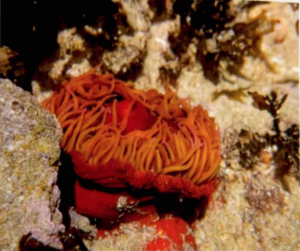
- Red or orange column (body) with pale yellow tentacles and purple tips.
- Unable to readily retract tentacles
- Diet consists of mussels and crustaceans
- Most toxic species of anemone
- Found in the low/mid intertidal zone
Plum Anemone Actinia ebhayiensis
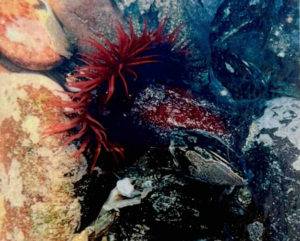
- Can be a deep plum or vibrant red color.
- Anemone’s tentacles are able to fully retract at low tide when exposed to air, allowing it to trap water in its body cavity to prevent dessication.
- Found in the low./mid tidal zone.
Sandy Anemone Bunodactis reynaudi
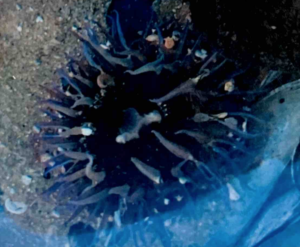
- Variable in coloration (brown, pink, blue, green, purple)
- Column covered in flattened, sticky knobs to which shells and sand adhere.
- Diet consists of dislodged mussels, urchins, and whelks.
- Found in the low/mid intertidal zone.
Violet Spotted Anemone Anthostella stephensoni
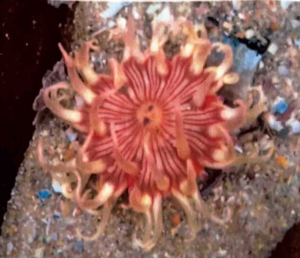
- Smooth cream or white column with violet spots at the center near the mouth. Violet strips radiate from the mouth to each tentacle. Tentacles are white.
- Found most frequently near or below tide level and at depths of up to 30m.
Striped anemone Anothothoe chilensis
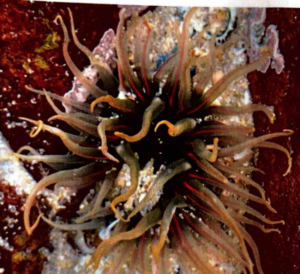
- Pale cream/white tentacles with a vibrant red stripe down the middle.
- Column is typically buried in the sand with tentacles sticking out.
- Found in the low/mid intertidal zone.
Crevice Anemone Anthopleura michaelseni
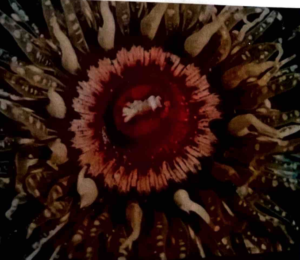
- Tentacles readily retract when disturbed
- Lives partially buried in sand, in rock crevices, and sandy pools.
- Found most frequently near or below tide level and at depths of up to 10m.
Hydrozoans
Bluebottle/Portuguese Man-of-War Physalia physalis
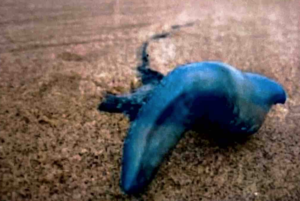
- Easily identifiable by blue, bubble-like body that floats on the surface of the water. Long protruding tentacles from below
- Tentacles up to 10m in length
- Regularly eaten by nudibranchs, plough snails, and seaswallow.
- Inflicts painful stings, do not touch
Platyhelminthes
Flatworms
Gilchrists flatworm Planocera gilchristi
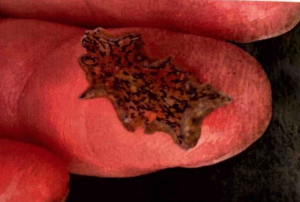
- Smooth, flat body surface with two tentacles situated near the front end
- Brown coloration with mottled black speckles
- Predates on mollusks, other worms, and small crustaceans
- Found in the low/mid intertidal zone
Carpet flatworm Thysanozoon brocchii
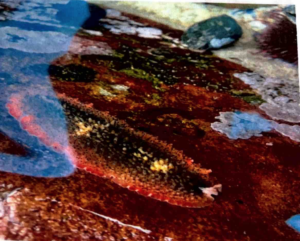
- Elongated body with pink/orange frilly margin
- Dorsal surface covered with pink to purple finger-like projections to camouflage the animal, also helps with oxygen exchange
- Found in the low/mid intertidal zone
Sipuncuclida
Peanut worms
Common peanut worm Golfingio capensis
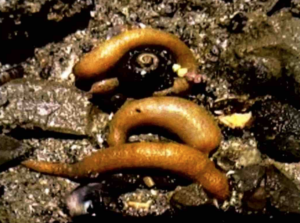
- Body is cream colored, resembling a peanut when retracted
- When feeding, the retractable proboscis can be seen
- Clusters under rocks/stones on rocky shores
Annelida
Class Poluchaeta (Bristleworms)
Blue Coral Worm Pomatoleios kraussii
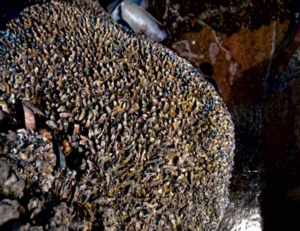
- Builds large blue colonies of interwoven tubes
- Head with two rows of feathery branches. When closed, a calcareous cap can be seen.
- Abundant on rocky shores, often fringing pool edges
- Distributed throughout the intertidal zone
Feather-duster Worm Pseudobranchiomma longa
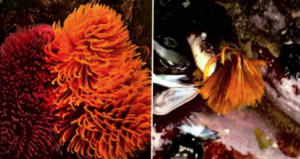
- Two purple/whitte or orange spirals which crown the head
- Solitary filter feeders
- Found in the low intertidal zone
Mussel worm Pseudonereis variegate
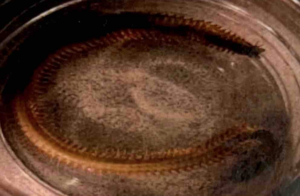
- Cylindrical, dark green coloration
- Common amongst seaweeds and mussels
- Eats small animals and seaweed
- Most commonly found under blue coral worm colonies
Arthropoda
Class Arachnida (True Spiders)
Formidable Shore Spider Desis formidabilis
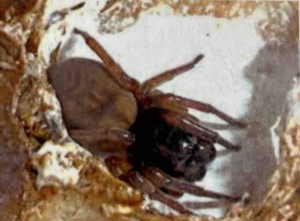
- Large fangs (⅓) of body length
- Commonly found under boulders in the mid/high intertidal zone
- Traps air bubbles in silk lined crevices to shelter from high tide
Class Insecta (Insects)
Marine springtail Anurida maritima
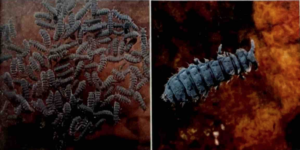
- Miniscule dark blue/grey body, 6 legs\
- Shelters in air pockets under rocks and shells at high tide
- Body is covered in velvet like hairs to repel water. At high tide, the fine hairs allow the animal to capture a bubble of air, enabling aerial respiration while underwater.
Subphylum Crustacea (Barnacles, shrimp, and crabs)
Toothed Barnacle Chthamalus dentatus
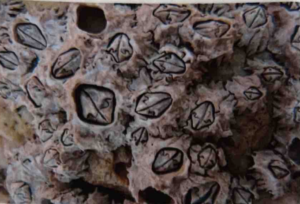
- Small flat, dirty white with a star shaped outline
- Commonly found in the mid/high intertidal zone
Grey Volcano Barnacle Tetraclita serrata

- Tall, dark grey, volcanic shaped structure
- Distributed throughout the entire intertidal zone, however more dominant in mid-intertidal area
- Prefers moderately sheltered shores
Eight-Shell Barnacle Octomeris angulosa
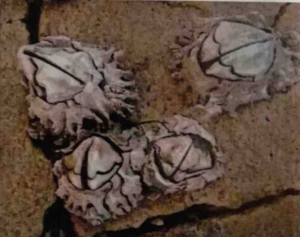
- 8 distinctive dirty white shell plates
- Found in the low intertidal zone
Variegated Spherical Isopod Exophaeroma varicolor
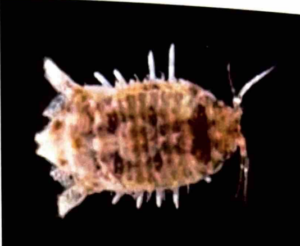
- Mottled shades of black/brown/cream
- Many subspecies exist but are grouped together in this guide
- Found in the low/mid intertidal zone
Compact Amphipod Lysianassa ceratina
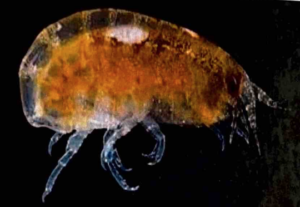
- Compact body in mottled shades of white, brown, and sometimes shades of red.
- Scavenges under stones, among algae, or in sand/gravel
Sand Shrimp Palaemon peringueyi
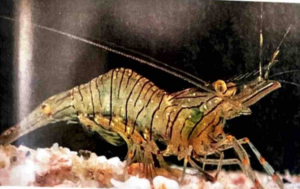
- Transparent with black stripes
- Lives in intertidal pools with sandy bottoms, most commonly found in the mid/high intertidal zones
- Scavenges fragments of decaying organisms
Common Sand Hermit Diogenes brevirostris
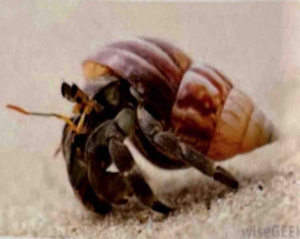
- Many subspecies, all grouped together for this guide
- Burrows during low tide, emerges to scavenges when submerged
- Distributed throughout the low/mid intertidal zones
Cape Rock Crab Plagusia chabrus
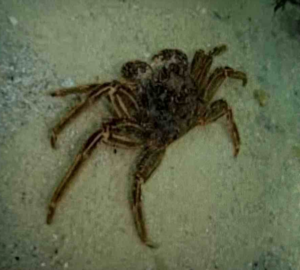
- Red/brown in color
- Carapace (upper shell) velvety and smooth in texture
- Orange/yellow ridges on legs
- 2 notches between the eyes that house the antennae and 3 marginal teeth
- Occurs in pools and shallow reefs
- Eats small animals and grazes on low-growing seaweed
Shore Crab Cyclograpsus punctatus
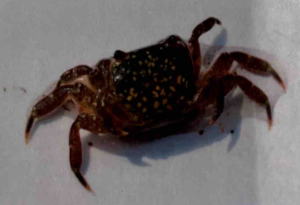
- Body smooth with granular chest
- Body is brown/black towards the front, blending to grey/green towards the back
- Lacking marginal teeth, although 1 single tooth below each eye is present
- Lives high on the shore
- Scavenges at night during low tide, feeding on drift seaweed and animal matter.